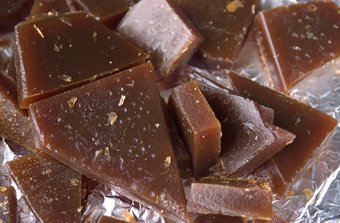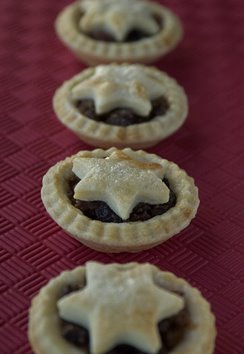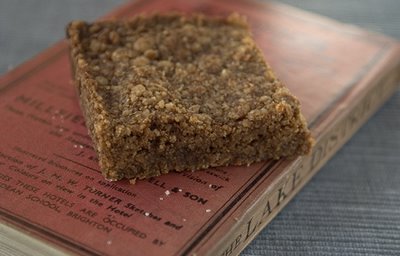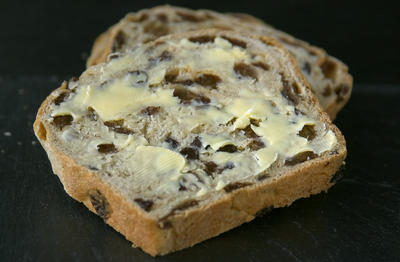
Early on Christmas morning Welsh Protestants held a carol service known as 'plygain' (as opposed to the Catholic Mass). This service could take place as early as 3 a.m. and might well last several hours. Plygain apparently means 'before cock-crow'. In order to stay awake until it was time to go to church/chapel, one activity that was traditionally practiced was toffee making. Noson Gylfaith means Toffee Evening.
As an aside, the word toffee is comparatively new (19th century), and in Wales the sweet would have been known as cyflaith, ffanni, and most commonly taffi (taffy). American-English uses the word 'taffy'. Taffy is generally pulled, whereas toffee (as the English make it) is generally poured out and left to set. In Britain the word toffee now appears to be used to describe both forms.
Toffee Evening was a sociable occasion. Family and friends would gather to boil up a pan of sugar and butter, and then take it in turns to 'pull' the toffee. The strands of toffee would curl and were supposed to reveal the initials of your true love. Pulling toffee was quite a skill, so if you wanted to manipulate your toffee into the initials of someone you had your eye on, then you had better get some practice in on the sly. Alternatively, the pulled toffee would be chopped up into shorter mouth-sized lengths.
I was keen to try making some homemade toffee, but I was a bit intimidated by the idea of using my hands to work with the molten sugar straight from the pan. Still, what's Christmas without a bit of trauma. Here goes...
My recipe comes from the website of St Fagans National History Museum. I have halved the quantity of ingredients to:
675g soft brown sugar
225g salted butter
juice of 1/2 lemon
1/8 pint of boiling water
I followed the instructions given on the St Fagans website (first melt the sugar in the water, then add the lemon juice and butter), but I had the benefit of a sugar thermometer to help me judge when the target temperature had been reached. A watched pan of boiling sugar does take an age to reach the temperature, so patience is definitely needed for this. As I am not very patient I spent my waiting time browsing through cookbooks to find any last minute advice on toffee pulling. Help came in the form of the Roux brothers' book on Patisserie. In it is advice on working with sugar to create fanciful decorations for patisserie - poured, blown, pulled and spun sugarwork. One of the Monsieur Rouxs advises using a palette knife to start working with the hot sugar after it has been poured out onto a greased (ideally marble) surface. The coolness of the surface begins to lower the temperature of the toffee/sugar. He then writes, 'Now your fingers can hold the mass without making contact with the marble. After two or three minutes, hand and sugar are finally and completely united; they seem to have attained precisely the same temperature. The sugar bends, takes on a satin sheen. Suddenly it sings, it makes a slight cracking sound, it talks to you. Proud, beautiful, docile, it is now ready to be shaped into flowers, leaves, animals, what you will.'
By now I was looking forward to listening to my toffee sing, and lo and behold it was time to take the pan off the stove.
I poured some of my hot toffee onto a buttered plate, and the remainder went into a greased tin (a back-up plan). I used a palette knife to start moving the toffee around, and then plunged in with my fingers. Once you have picked up some of the toffee and started manipulating it, the heat dissipates fairly rapidly. The toffee becomes more elastic and less fluid the more you stretch it. The colour of the toffee lightens as you incorporate air, and becomes a lovely creamy coffee colour. Once I got the hang of the pulling I was then a bit stumped as what to do with my pulled toffee. I twisted some of it, and cut it into smaller pieces.


By complete chance, the initial spelt out in curly toffee was that of my husband, and a heart-shape also formed (see top of posting).
The toffee in the tin I marked out into squares once the mixture had cooled sufficiently. The tin then went outside the back-door, to take advantage of the chilly air to assist further cooling (but I kept an eye out for pesky London squirrels, who will make off with anything that isn't bolted down).

Once cool (and retrieved from the squirrels), I attempted to snap the toffee along the pre-scored lines. Some of the toffee was obedient, and on other sections it seemed more likely that my fingers would be doing the snapping, so I let it break freestyle. Large pieces of splintered toffee do look more attractive, but they can be rather big to get in your mouth in one go.


The pulled toffee had a softer consistency and was an easier chew. The poured toffee gave a better mouth and jaw workout (but don't tell your dentist). What intrigued me was how the Welsh could spend hours singing carols, after an evening of making and consuming toffee. After a couple of pieces, my teeth were fair stuck together and I was reduced to loud humming. Perhaps these things happen for a reason?
With best wishes for a Happy Christmas.
For information on other Welsh Christmas traditions and to hear some plygain singing, click here.













































